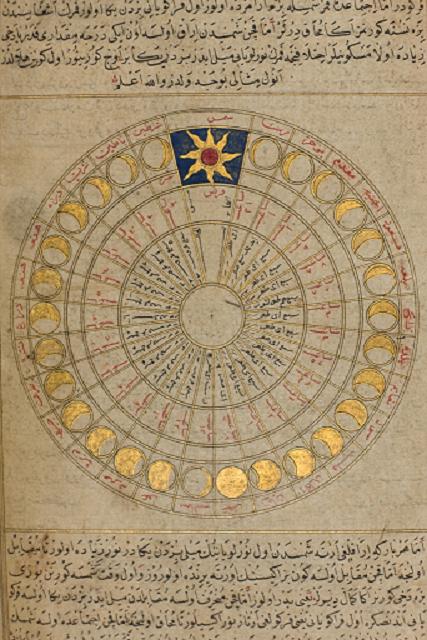
According to the Islamic narrative in Sūrat al-Tawba, the term nasī’ indicates postponement, that is the postponement of the sacred month of Muḥarram. The Arabs delayed it for a year, and sacralised other months in its place due to their need for fighting and raiding. The term nasī’ in Arabic comes from the saying: “We overlooked some of your days, and Allah overlooked some of your life”, that is, Allah has increased the number of the days in your life and its duration, so that you may live longer. So it indicates any form of increase that has occurred.
BY JADOU JIBRIL
THERE ARE VARIOUS EXPLANATIONS for the reason for these postponed days, with some believing that they were subject to the higher or lower calculations of the moon’s rotation around the Earth, and others maintaining it was a way to get round the number of days of the sacred months when the Arabs wanted to avoid fighting or raiding based on the preparedness or no of the tribes to engage in it. Deciding this matter was entrusted to the tribal chiefs. Islam later forbade the days of the nasī’ to avoid the extreme variations that it could cause in calculating the timings of Islamic rites and festivals according to the Islamic perspective.[i]
In the commentary by Al-Sa‘dī it was stated that the nasī’ was used by the pre-Islamic peoples during the sacred months, and was one of their false beliefs. When they saw a need to engage in fighting at certain times in the sacred months, they made sure – in their corruption – to maintain the number of sacred months where God forbade fighting, and either delay them or bring them forward. The months put in their place provided the solution they wanted, and by substituting this month they licensed fighting for the period, or alternatively they turned the month when this was permitted into a forbidden month. This was the ‘excess of disbelief ‘ and their ‘misguidance.’
Now to this day there are some Islamic rites and festivals whose timings vary between Islamic countries, and they will remain so until God inherits the earth and those upon it.
It seems that the ancient Arabs always sought to match the months of the lunar calendar with the seasons of the solar calendar – something which was actively relevant to their practical lives. Islamic adjustments, however, contributed to making the months of the Islamic hijrī year wander through the seasons, which means that they lost their effectiveness in daily life and are today no longer valid other than as a means to define a set of Islamic laws.
With the adoption of the pure lunar calendar and the obligatory visual sighting of the crescent moon, and with regard to the variation of the timings of some important Islamic rituals and festivals in the various Islamic countries, it was astrophysics that demonstrated how easy it is to determine the beginning of the lunar months and the crescent moons. And it has done this for thousands of years, not just for one or two years. Nevertheless, the differences seem to lie in the legal texts that focus on the phrase ‘visual sighting’, in that a sighting on its own does not take into account factors such as the state of the atmosphere and does not make it part of the calculation. The visibility of the full moon cycle varies according to geographical location, which means that the hijrī month may begin in one place but not in another.
The mercurial, reverential, justificatory mentality did not miss the chance to dispense with the potential of astrophysics
The jurists differed on how to confirm the sighting of the crescent moon of Ramadan. Some of them made the confirmation of seeing the crescent moon of Ramadan dependent on some certificate of justice in the observer, while others made the condition its sighting by a large number of people gathered together. However, the mercurial, reverential, justifying mentality – as usual – found a solution: it recognised the sighting made by each country and did not insist on it being imposed upon the people of another country. Any dispute that may arise was to be referred to the ruler in charge, in order to preserve unity and prevent discord. Thus the matter was settled.
Clearly, the differences that sometime occur among Arab and Islamic countries in determining the lunar months and specific holidays lies in the desire of some rulers to exercise a kind of sovereignty and independence of decision, even though it is actually a doctrinal matter and supposed to be far removed from politics or worldly purposes.
The mercurial, reverential, justificatory mentality did not miss the chance to dispense with the potential of astrophysics for determining the beginning of the lunar months and the crescent moons. They repudiated it in order to get out of the embarrassment. But this was only worse than keeping silent about the entire issue. This mentality maintained that astronomical calculations were not yet conclusive enough from the legal perspective, because they were conclusive ‘in negation and not in proof’. The reason being that if the astronomical calculations confirmed that the crescent was not appearing, this was something that was accepted as established, and no one could rightly claim to have seen it. But if, on the other hand, it confirmed that it had appeared, a person could nevertheless say that he did not see the crescent, perhaps because he did not have the exact instruments and scientific knowledge of the physicists. This is a logical fallacy.
Is there some reason, not explicitly stated to the public, for the abolition of the nasī’ at some point in Islam?
The Hijrī year: some facts about the lunar calendar that preceded Islam by two hundred years
The hijrī/lunar calendar is based on measuring the lunar cycle around the Earth, so that the hijrī month is completed with the full cycle of the moon. This is in contrast to the Gregorian/solar calendar, which is based on the Earth’s rotation around the Sun. The end and beginning of the hijrī month are measured based on the sighting of the crescent of the new moon, which makes the days of the hijrī months indefinite, unlike the solar calendar. Accordingly, the number of days in the hijrī month varies between 29 and 30 days, so that the lunar year has been wandering through the seasons of the year since the revelation of the verse that nullifies the nasī’. The hijrī year advances 11 days each year, as compared to the solar calendar, something which makes Islamic rituals and occasions fall at different times and in different seasons each year, unlike what was the case before the Farewell Pilgrimage, which took place in the year 10 AH.
The ancient Arabs were careful to avoid the imbalance between the lunar calendar and the solar calendar, knowing that the former is not as exact as the second and does not correspond to the sequence of seasons. This is important for agriculture, agriculture-related work and the herding life. These become confused when one relies on the lunar calendar.
The mercurial, reverential, justificatory mentality did not miss the chance to dispense with the potential of astrophysics
The months among the Arabs were linked to the logic of the environmental-seasonal solar calendar, and no better evidence of this is their names, such as the ‘First Spring’ and ‘Second Spring’, which always coincided with the spring season, and Ramaḍān – so named because it came in the summer. But with the abolition of the nasī’ in Islam, things got muddled, and they continue to be muddled to this day. Note that the Islamic narrative holds the opposite, that the muddle was occurring before the prohibition of the nasī’.
All this has led to problems, not least that the hijrī month can end up finishing in one Arab-Islamic country but not in a neighbouring one, something which has led to a variation in the dates for some rituals among Muslims. I have not found in the Islamic tradition and narrative any convincing explanation that can explain away this confusion religiously and doctrinally, and what has been said in this regard is simply an attempt at justification, nothing else.
Now according to the Islamic narrative, the year in which the Prophet made his Farewell Pilgrimage was a year in which the month of Dhū ‘l-Ḥijja had returned to its original place in the year after having been changed by the people of the pre-Islamic era by adopting the nasī’, in that it was stated in a hadith that Time has come back to its original state which it had when Allah created the Heavens and the Earth,[ii] meaning that the month of Dhū ‘l-Ḥijja had wandered through the seasons and now coincided with the year 10 AH, its original place on the day of creation. The meaning of the hadith is that the months have returned to what they were before the adoption of the nasī’ in the first place.
Two centuries before Islam
Before Islam, the Arabs used to date years from the occurrence of a famous event such as ‘The year of the Elephant’ and ‘The year of the Day of Conflict’.
Arab elites gathered in Mecca in 412 AD to agree on the lunar calendar, since the divergence between Arab tribes in determining the lunar months was causing chaos for the pilgrimage season and for trade. The Arabs agreed on the number of months and their names. They also agreed on the activities to be associated with each month, months for war, months for trade, and months for pilgrimage. The sacred months, were also agreed upon, months in which fighting was forbidden, and this continued even after the advent of Islam, and remained up to the Farewell Pilgrimage at the end of the Prophet’s life.

Suggested Reading
The most important references in the historical Islamic narrative (the woks of al-Ṭabarī, al-Mas’ūdī, al-Bīrūnī, al-Maydānī, Ibn Khaldūn, al-Nuwayrī) acknowledge that the Arabic year before Islam was lunar-solar and consisted of 12 lunar months, modified by the nasī’ so the year turned in step with the solar year. The nasī’ was considered a holiday and was accompanied by some religious and doctrinal rituals. More than one Islamic authority has confirmed that the Arabs adopted the nasī’ from the Jews. The ancient Arab year, at least in Makka, was a solar year based on seasonal climatic and environmental considerations. It seems that it was divided into 6 sections, each consisting of two months, thus the two Ṣafars, the two Jumādīs, the two Rabī‘s.
[i] Qur’ān IX (al-Tawba), 37: Postponement (of a sacred month) is only an excess of disbelief whereby those who disbelieve are misled; they allow it one year and forbid it (another) year, that they may make up the number of the months which Allah hath hallowed, so that they allow that which Allah hath forbidden. The evil of their deeds is made fair-seeming unto them. Allah guideth not the disbelieving folk. Reposition this footnote to the first sentence

